Introducing Puppy to Kitty
If you already have a cat in your home, introducing a dog to the mix can be rather unsettling, to both of the animals, as well as to you. The entire relationship may hinge on how the initial introduction goes, so it’s important that you control the experience.
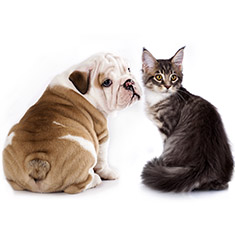
In many shared-species homes the cat quickly asserts his or her dominance over the dog. Oftentimes a swipe of the claws across the dog’s nose or a loud hiss accompanied by the cat’s hair standing on end is all it takes. However, if the dog has a high prey drive and the cat chooses to run away rather than facing the dog, you may forever be trying to convince the dog that the cat is not a chew toy or an appetizer.
Choosing the Right Dog for Your Cat
If you already have a cat in your home, it’s worthwhile to take the time to find a dog who can peacefully co-exist with your cat. Tell the breeder or shelter worker that you have a cat, and ask if the dog you are considering has been evaluated around cats. They should be able to tell you whether or not the dog is cat-friendly.
If you’re at a shelter, you may even be able to walk a cat past the dog runs or walk a dog past the cat kennels to see what happens. What you’ll be testing is the strength of the dog’s prey drive. Ideally, you want a dog with a very low prey drive, or at least one who doesn’t see cats as the ideal prey.
Assessing Your Dog’s Prey Drive
Dog behavior is driven by four main instincts: pack, prey, fight, and flight. Dogs who are driven by their pack instincts love to be around other animals and people. The prey drive is what makes your dog hunt or chase anything that moves. Dogs ruled by their fight drive are self-confident and enjoy games like tug-of-war. The flight drive causes a dog to run away or hide rather than confronting new situations.
Each dog has all four instincts, but usually one of them will be dominant. Partially determined by breed, partly by training and environment, the dominant drive determines how your dog will react to new situations or stress. The most important drive to assess when determining if a dog will get along with your cat is the prey drive.
Historically, the prey drive is responsible for the survival of the canine species because it allowed early dogs to catch their food. Breeds that have been domesticated for the purpose of hunting or herding have been selectively bred to reinforce the prey drive. If the puppy or dog you intend to bring home has a high prey drive, it doesn’t mean the dog will forever chase the cat, but it does mean you will have to take a very controlled approach to the introduction.
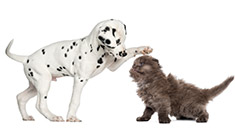
A quick way to assess a dog’s prey drive is to simply observe the dog around wildlife such as squirrels and chipmunks. Does the dog zero in on the wildlife, barking incessantly and trying to get to the prey in spite of all obstacles? Or does the dog bark a little, then find something else of interest when it becomes clear he cannot catch the little critter?
If there are no woodland creatures available when you are assessing the dog, see how strongly the dog engages with you when you try to simulate prey. Make a high-pitched noise and run a little distance away from the dog. Does he give chase or does he look for a place to hide from the noise?
For a more formal assessment, you can evaluate your prospective pet using the C-BARQ tool from the University of Pennsylvania’s Center for the Interaction of Animals and Society. If the dog in which you are interested is in a shelter, you might ask the staff to evaluate the dog using the American Temperament Test Society’s protocol.
Planning the Introduction of a Dog and a Cat
Once you have determined how strong the prey drive is in your dog, you will begin planning his first encounter with your cat. Your planning will revolve around controlling the environment where the introduction is to take place. At a minimum, you want to have a calm place without distractions like screaming children or loud music. Spend some time petting your dog and trying to get him calm and relaxed before you bring the cat into the situation.
For a dog with a very low prey drive, it may be as simple as putting your cat on one side of a baby gate and walking your dog past the gate to see what happens when he gets a whiff of cat scent. If all goes well, you can allow them to interact more fully.
However, if your dog has a high prey drive, you will need to take the time to carefully plan how the early encounters between the dog and the cat will be handled. Until you have firm control over your dog, it’s best to keep the cat totally isolated from the canine. You might have to divide your house into two separate zones; one for the cat and one for the dog. Give some consideration to where you might place baby gates or what doors need to remain closed until you are prepared to make the proper introductions.
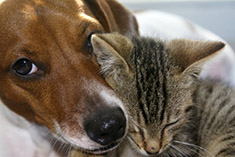
Make sure your cat has an escape route. Cats would much rather run than fight, for the most part, so you should be sure they can jump over a baby gate, hide under a bed, or leap to the top of the refrigerator if they need a break.
You may want to introduce the dog’s scent to the cat or vice versa by rubbing a towel over the animal’s body and placing it in the other pet’s sleeping quarters. Once they can smell the towel without getting overly excited, put the cat in another room and let the dog check out the cat’s favorite spots so he recognizes that there are several places in the house that will smell like the towel smells. Do the same for the cat.
Controlling Your Dog While Meeting a Cat
Once you have the environment as calm as you can possibly get it, you need to think about how you will control your dog. You might play extensively with the dog before bringing the cat into the picture so your dog will be a little on the tired side, making a chase slightly less likely. In addition, make sure the dog is not so hungry that the cat looks like a tasty snack.
Leerburg Kennels highly recommends crating your dog or at least keeping him on a leash until you are sure of his response to the cat. They recommend putting the dog on a leash when he enters the house for the first time so that he realizes the house is a place to be calm. The dog is led to his crate and locked up, then the cat is allowed to come into the room.
If the dog barks or tears up the crate trying to get out, they scold the dog, then use discipline if the barking doesn’t stop. They recommend covering the crate with a sheet, spraying lemon water in the dog’s face, or using a no-bark collar if the dog is older than four months. Following any correction, make sure to spend some time loving on your dog so he knows you aren’t carrying a grudge and that you “hate the sin but love the sinner.”
When they want the dog to have some out-of-crate time, they simply lock up the cat in another room. Once the dog has gone at least a week without barking at the cat from his crate, the dog is allowed to roam the house on a leash, possibly with a muzzle, depending on how aggressive the dog becomes.
Aggression is handled by correcting the dog strongly enough to make him think before the next time he wants to put the cat in her place. The goal is to make the dog realize that the cat is part of the family pack structure, and should be accepted as such.
Leerburg recommends that you also treat the cat as part of the pack, scolding the cat when she teases the dog by staying just out of reach from the end of his leash, then runs around to excite the dog’s prey drive. Scolding the cat tells the dog that you are the alpha leader of the house, even above the cat (although the cat will never admit this).
Using rewards
Both the cat and the dog should be rewarded for good behavior. Each time they meet without starting World War III, both should get lots of praise and possibly even a treat or two.
Be prepared for this to be a long process, often taking a month or more before you can be sure your dog will not harm your cat. Use short visits at first, and reward even the baby steps you see as they learn to co-exist.
For more information
PAW Rescue has an extensive library of tips about introducing your dog to cats, to other dogs, and to people.
Doggies Den: Latest Articles
 Homemade Thanksgiving Treats for Your Dog
Homemade Thanksgiving Treats for Your Dog
NUTRITION We all want to include our dogs in our holiday celebrations, but hopefully, you're aware that sharing table scraps with your dog isn't always the best idea.
 Keeping Your Dog Safe during the Summer Months
Keeping Your Dog Safe during the Summer Months
HEALTH Summer is coming on fast, so it’s time to plan how you will keep your dog safe and healthy through the lazy, carefree, warm days.
 Vaccination Time Again-Keeping Your Puppy Healthy
Vaccination Time Again-Keeping Your Puppy Healthy
DOG HEALTH So you have your new puppy picked out. There are quite a few shots, treatments and examinations that will keep the newest member of your family healthy.
 Canine Thanksgiving Feast
Canine Thanksgiving Feast
NUTRITION With the wide variety of food at Thanksgiving dinner, chances are you'll want to give your dog something special, too. If you're contemplating what to feed your dog for the holiday, here is a guide to a great Canine Thanksgiving Feast.
 Dog Walking Tips Every Owner Should Know
Dog Walking Tips Every Owner Should Know
DOG FUN Walking your dog is not only crucial to keeping him healthy and happy, it strengthens the bond between your canine friend and his caregiver. There are a lot of obstacles out there. Don’t forget these simple tips to keep your walk fun and safe in the outside world.
 The Benefits of Physiotherapy for your Dog
The Benefits of Physiotherapy for your Dog
HEALTH The same techniques that physiotherapists use to treat a variety of injuries and conditions in humans have been adapted to suit animals with great success. Family pets, show dogs, and working dogs can all benefit greatly from physiotherapy. Dogs whose activities involve a lot of agility are especially susceptible to the types of problems that physiotherapy can address.
 The Decision- Adding a Dog to Your Family
The Decision- Adding a Dog to Your Family
FIRST TIME OWNERSBringing a dog into your family is a decision where many people don’t realize it’s magnitude until after they have the dog. There are a number of things that you need to research before you decide to purchase a dog, and it starts right in your own home.
 Bringing Your Dog Into Your New Baby's Life
Bringing Your Dog Into Your New Baby's Life
HEALTH Many believe that a dog and a new baby cannot happily coexist, so therefore the dog has to go. This is not necessarily the case.  A new baby does not mean you have to abandon your dog.

Doggies Den:
Most Popular Articles

Dog Pregnancy Symptoms
HEALTHIf you suspect your dog might be pregnant, check out part one in this series on pregnant dogs, where we cover pregnant dog symptoms.
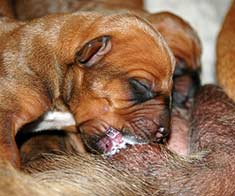
Dog Birth
HEALTHIn the third article of our dog pregnancy series, we look at the wonderful, but messy, process of bringing newborn puppies into the world.

Indoor Dog Potties
DOG PRODUCTSIt's been a long day at work. You were so busy, you didn't even take time to eat a sandwich, let alone run home to let your dog out. You're on your way home, knowing the poor dog is crossing his or her legs by now, when your car breaks down, delaying you even further. Can't somebody make this easier?
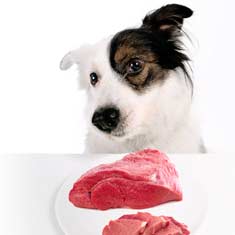
Your Dog’s Digestive System
PHYSIOLOGYEver wonder why your dog eats so fast? Or why he eats gross things? Or why he gets sick to his stomach? Or why his waste stinks so bad? Some of these things are normal, some are not.

Canine Respiratory System
BREATHINGThe basic function of your dog's respiratory system is to bring oxygen in to and remove carbon dioxide from the body. Knowing the symptoms of respiratory diseases can help you help your stay healthy.
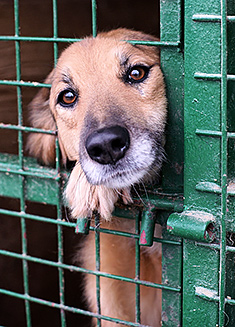
Shelter Dog Adoption Tips for Success
ADOPTION Are you intimidated by the prospect of "rescuing" a dog from a shelter? One reason that you may be wary of adopting a dog from a shelter is not knowing how to choose. Adopting a dog from a shelter can be a rewarding process, if you're prepared to do a reasonable amount of research.

Canine Urinary Tract Infections
SYMPTOMS AND TREATMENTDoes your dog seem to be having trouble relieving his or her bladder? Learn how to recognize the signs of urinary tract infections and how to treat them before they spread.

What to do for Dog Diarrhea
SYMPTOMS AND REMEDIESIf you have dogs in your house for any length of time, you have likely experienced at least one bout of dog diarrhea. Beyond the pain in the tuckus involved in cleaning up the mess, you should know what causes diarrhea, and when it's important to see the vet.

What to do for a Dog Bite
DOG BEHAVIOR Getting bitten by a dog can be scary, and you may be tempted to run around in circles for a while, trying to figure out what to do. Here's our guide to help you manage the situation.

Top Ten Tips for Living with a Senior Dog
DOG HEALTH Bringing home a new puppy is so exciting, but it doesn’t take all that long for your exuberant puppy to grow into a senior dog who may have special needs. Here are the doggies.com top ten tips for taking care of your companion who has been with you through so much.
